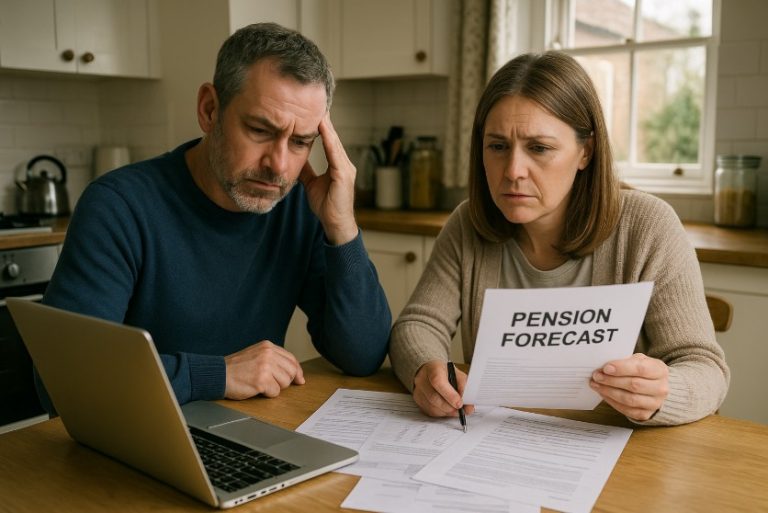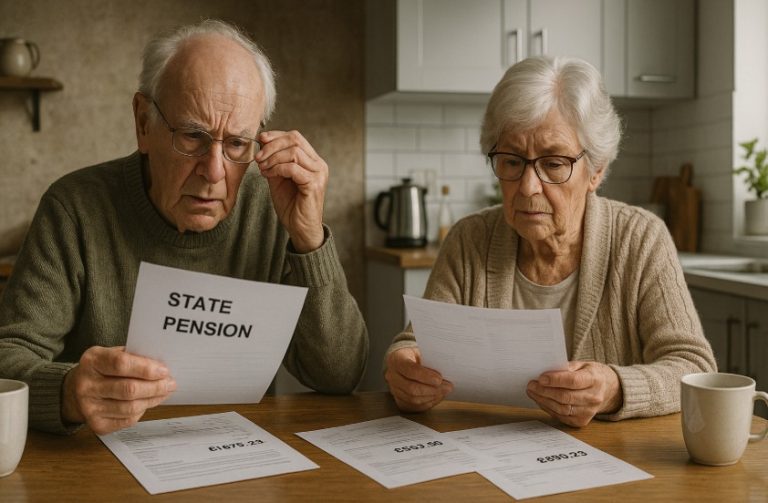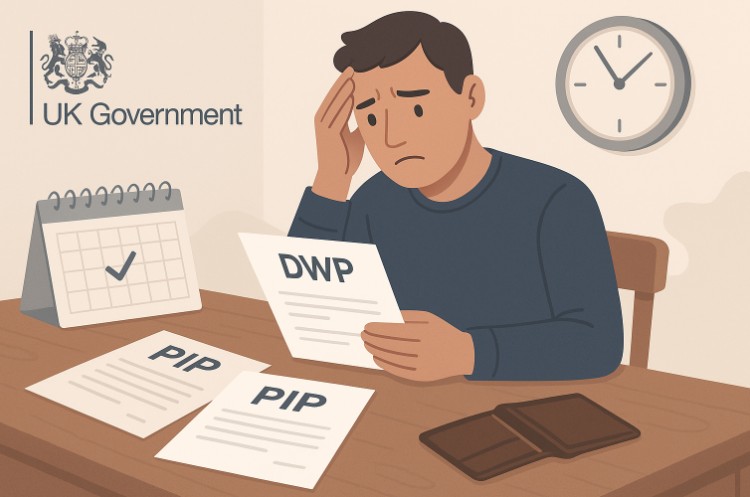Ever noticed a payment labelled “DWP SP” on your bank statement and wondered what it means?.
This abbreviation refers to the State Pension, paid by the Department for Work and Pensions (DWP) to individuals who have reached the qualifying age.
With various government codes appearing on statements, it’s important to understand what each one signifies.
This guide explains the meaning of DWP SP, who receives it, and how it fits into the broader UK pension system.
What Does DWP SP Stand For On A Bank Statement?

The code DWP SP on a bank statement indicates a payment from the Department for Work and Pensions (DWP) related to the State Pension.
This entry is typically seen by individuals who have reached the qualifying State Pension age and are receiving regular pension payments.
The abbreviation breaks down as:
- DWP: Department for Work and Pensions
- SP: State Pension
This is a standard government-issued code that appears on bank transactions as a way to identify the source and type of payment.
If a person is receiving State Pension payments, their bank will display this abbreviation alongside the deposited amount, helping account holders verify the nature of the transaction.
Who Sends The DWP SP Payments And Why?
The Department for Work and Pensions (DWP) is the UK government department responsible for administering a range of social security and welfare-related payments.
One of its key roles is to manage the delivery of the State Pension, and when you see “DWP SP” on a bank statement, it signifies a State Pension payment made directly by this department.
The DWP issues these payments as part of its legal and administrative obligation to support UK residents who have reached the State Pension age and have accumulated sufficient National Insurance contributions throughout their working lives.
These payments are made to eligible individuals to provide a reliable and stable income in retirement.
There are several reasons why DWP SP payments are made:
- To ensure citizens receive the pension they are entitled to under UK law
- To support the financial wellbeing of older individuals who may no longer be earning
- To reflect the individual’s contribution history to the National Insurance system
The DWP uses modern digital banking systems to make these payments directly into recipients’ bank accounts.
Once the pension is set up, the payments are usually made on a weekly or four-weekly basis, depending on the claimant’s preference and how their pension was initially arranged.
For pensioners living abroad, the DWP can still arrange for the State Pension to be paid into an overseas bank account, although payment frequency and currency exchange processes may differ slightly.
Because the DWP manages multiple benefits, it uses different codes for each type of payment. “DWP SP” is specific to State Pension, helping recipients and banks identify the source of the funds without confusion.
In short, the DWP sends SP payments as part of its commitment to honouring the pensions of citizens who have spent decades contributing to the UK’s social insurance framework. These payments form a critical part of the UK’s retirement income landscape.
What Is The SP In DWP SP Referring To?
The “SP” in DWP SP stands for State Pension, a government-provided retirement benefit designed to offer financial support to individuals who have reached a specific age and meet the required contribution criteria.
The State Pension is not a universal benefit. Instead, it is earned through years of contributions to the National Insurance system.
People who work in the UK and pay National Insurance accumulate credits that go towards their pension entitlement. The more qualifying years they have, the larger their pension is likely to be, up to a capped maximum.
There are two main types of State Pension currently in the UK system:
- Basic State Pension: This applies to men born before 6 April 1951 and women born before 6 April 1953. It requires a minimum of 30 qualifying years of National Insurance contributions or credits and pays a fixed weekly amount.
- New State Pension: This applies to those reaching pension age on or after 6 April 2016. It generally requires 35 qualifying years for the full weekly amount. The system is designed to be simpler and more transparent, especially for people with interrupted work histories or a mix of employment types.
The “SP” reference helps distinguish this type of payment from other benefits such as:
- PIP (Personal Independence Payment)
- UC (Universal Credit)
- ESA (Employment and Support Allowance)
This designation ensures that banks, account holders, and support services can quickly identify the nature of the payment.
In practice, the SP payment forms the backbone of retirement income for millions of UK residents. It is intended to ensure that those who have contributed to the economy and society through work and taxes are not left without basic financial support in later life.
The term SP is a simple abbreviation, but it carries significant meaning—highlighting the result of decades of work and contribution.
When it appears on a statement, it confirms that the recipient is now drawing from the pension system they helped fund over their working lifetime.
Who Is Eligible To Receive DWP SP Payments?

Eligibility for DWP SP payments is dependent on several key factors. These include:
- Reaching the qualifying State Pension age, which is currently 66 but set to rise
- Having a minimum of 10 years of National Insurance contributions for any State Pension
- Building up 35 qualifying years to receive the full New State Pension
Some individuals may qualify through:
- Paid employment with National Insurance deductions
- Voluntary National Insurance contributions
- National Insurance credits (e.g. for carers, parents, or those receiving certain benefits)
Eligibility is not influenced by personal income or savings, which distinguishes the State Pension from means-tested benefits like Pension Credit.
How Often Are DWP SP Payments Made?
DWP SP payments are made either weekly or every four weeks. The payment schedule depends on the setup chosen by the pensioner during their application process. Most new recipients under the New State Pension scheme receive payments every four weeks.
The specific day of payment is determined by the final two digits of a recipient’s National Insurance number. For example:
| NI Number Ending | Payment Day |
| 00 to 19 | Monday |
| 20 to 39 | Tuesday |
| 40 to 59 | Wednesday |
| 60 to 79 | Thursday |
| 80 to 99 | Friday |
If a scheduled payment date falls on a public holiday, DWP often adjusts the payment date to ensure that recipients still receive their money on time.
How Can Someone Confirm A DWP SP Payment?
Individuals can verify DWP SP payments through several reliable methods:
- Review the bank transaction label, which typically reads “DWP SP” followed by a code or reference number
- Log in to their State Pension account via GOV.UK to see recent payment history
- Check their State Pension award letter, which outlines payment frequency and expected amounts
If discrepancies arise or an unexpected amount is received, the person should contact the Pension Service for clarification.
In some cases, overpayments or backdated entitlements can result in adjustments to payment amounts. Being aware of how to verify these payments can help ensure transparency and prevent misunderstandings.
What Should You Do If You Receive An Unexpected DWP SP Payment?
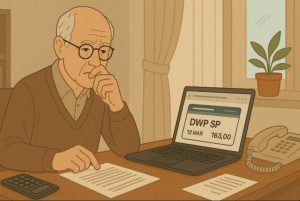
While most DWP SP payments follow a regular schedule and known entitlement, there are occasions where a person might notice an unexpected deposit labelled “DWP SP” in their bank account. This can cause understandable concern, especially if they were not anticipating a pension payment or if the amount seems incorrect.
It’s important not to panic. There are several legitimate reasons why an unanticipated DWP SP payment may appear, and taking the right steps can help clarify the situation quickly and avoid potential issues later on.
Possible Reasons For An Unexpected Payment
Unexpected DWP SP payments may occur due to administrative updates, changes in personal circumstances, or data corrections within the DWP system. Some of the most common reasons include:
- Backdated Entitlement: You may have recently become eligible for the State Pension, or a review of your National Insurance record might have resulted in a reassessment. In such cases, the DWP may issue a back payment covering weeks or months of missed pension.
- System Adjustments: If the DWP identified an error in earlier payments, they might issue a correction. This could be an additional amount to rectify an underpayment or a recalculation due to new information.
- Change in Pension Status: A change in your personal status, such as reaching a higher pension tier, updated marital information, or transfer of pension rights, can result in an altered or one-off payment.
- Receipt of Another Person’s Payment: Occasionally, payments intended for another individual (such as a spouse or recently deceased relative) may be misdirected due to linked accounts or shared banking details.
- Annual Uplift or Inflation Adjustment: The government usually applies an annual increase to State Pension payments in April under the Triple Lock If this results in a recalculation for previous months, you might see a larger deposit than expected.
Steps To Take If You Are Unsure About A DWP SP Payment
If you find a payment you don’t understand, it’s best to act promptly and follow these steps:
- Check Your Pension Award Letter or Online Account: Log in to your State Pension account via GOV.UK to see if there have been updates to your payments or entitlement. The account usually reflects any recent changes or adjustments.
- Review Correspondence From DWP: Sometimes, a letter or notice may be sent to inform you of payment updates. If you have received communication recently, it may explain the unexpected payment.
- Do Not Spend The Money Immediately: Until you understand the reason for the deposit, it is advisable to keep the funds untouched. If it turns out to be an overpayment, the DWP may request a refund.
- Contact The Pension Service For Clarification: The best course of action is to contact the Pension Service Provide your National Insurance number and the date and amount of the payment. They will be able to confirm if the payment was correct, and if not, what steps to take.
- Check For Updates Or Appeals: If you’ve recently appealed a pension decision or applied for a pension increase, the payment could be linked to that process. Always follow up on any ongoing applications or disputes.
By following these steps, individuals can ensure they remain compliant and informed about their pension entitlements. The DWP typically provides clear guidance in cases of overpayment, and genuine entitlement errors are often resolved without penalty if addressed quickly.
Being proactive helps avoid future complications, especially if further automated payments are scheduled based on incorrect data.
What Are The Other Common DWP Payment Codes?
The DWP uses several standard codes for different types of payments. Recognising these can help individuals manage their finances more effectively.
| Code | Benefit Type | Description |
| DWP SP | State Pension | Retirement income based on NI contributions |
| DWP UC | Universal Credit | Monthly payment for low-income households |
| DWP ESA | Employment and Support Allowance | Support for people unable to work |
| DWP PIP | Personal Independence Payment | Benefit for disabled individuals |
| DWP JSA | Jobseeker’s Allowance | Financial support while job hunting |
| DWP CA | Carer’s Allowance | For people caring for someone full-time |
By understanding these codes, individuals can quickly determine the nature of government deposits into their accounts.
Can DWP SP Payments Be Taxed?
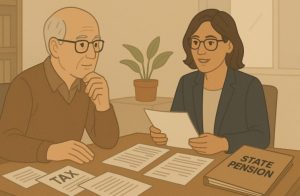
Yes, State Pension payments are subject to income tax in the UK. However, the Department for Work and Pensions does not deduct tax at source. Instead, HM Revenue and Customs (HMRC) monitors individual income levels and applies taxation accordingly.
Key tax considerations include:
- The personal allowance for tax-free income is £12,570 (for 2025/26)
- If a person’s total income, including State Pension and other earnings, exceeds this allowance, they will be taxed on the surplus
- Many pensioners who receive other private or occupational pensions may find themselves liable for income tax
In such cases, HMRC will either adjust other sources of income to collect the tax or request completion of a Self Assessment tax return.
How Does DWP SP Differ From Other Government Benefits?
DWP SP differs in several major ways from other benefits administered by the Department for Work and Pensions:
- It is not means-tested, meaning it does not depend on your current income or savings
- It is a contributory benefit, earned through years of National Insurance contributions
- It is designed to provide a baseline retirement income, whereas benefits like Universal Credit or Housing Benefit support day-to-day costs based on financial need
Comparing key DWP benefits:
| Benefit Name | Means-Tested | Based on NI Contributions | Typical Purpose |
| State Pension (SP) | No | Yes | Retirement income |
| Universal Credit (UC) | Yes | No | General cost-of-living support |
| Carer’s Allowance | Yes | No | Support for carers |
| Jobseeker’s Allowance | Partially | Yes/No (depending on type) | Support during unemployment |
Understanding these distinctions helps individuals determine which benefits they may be eligible for and how those benefits are calculated.
What Help Is Available For Understanding DWP Bank Statement Entries?

Various tools and services are available to help individuals interpret DWP payment codes like DWP SP:
- GOV.UK Pension Tools allow users to check their pension forecast and view detailed payment schedules
- Citizens Advice offers free guidance for those confused by benefit payments or abbreviations
- Age UK provides support tailored to older adults dealing with pensions and benefits
- Pension Service Helpline can provide direct answers to queries about payment amounts and frequencies
These resources are valuable for anyone who needs help navigating the UK benefits system and understanding how government payments appear in their financial records.
Conclusion
DWP SP on a bank statement is a straightforward yet essential code indicating a State Pension payment issued by the Department for Work and Pensions.
As the UK’s ageing population grows, clarity around such abbreviations is more important than ever. Understanding this entry helps ensure you’re informed about your entitlements and helps prevent confusion over your income sources.
FAQs
What if the DWP SP payment is less than expected?
This may be due to partial contributions, a change in entitlement, or deductions related to tax. Contact DWP or check your pension forecast online.
Can you get DWP SP if you’ve never worked in the UK?
You may be eligible if you’ve built up National Insurance credits through other means such as caring responsibilities or receiving certain benefits.
What’s the minimum National Insurance contribution needed for State Pension?
You need at least 10 qualifying years to get any State Pension and 35 years for the full amount under the new system.
How do I stop DWP SP payments if the recipient has passed away?
Notify the DWP immediately through the Tell Us Once service, which informs all government departments at once.
Is there a delay in DWP SP payments during bank holidays?
Yes, payments are sometimes made earlier if the regular payment date falls on a public holiday.
Can you change the bank account DWP SP goes into?
Yes. You can contact the Pension Service or use the State Pension account service online to update your payment details.
How do I contact the DWP about my State Pension?
You can contact the Pension Service by phone or post. Details are available on the official gov.uk page.


